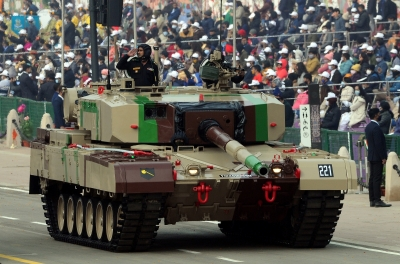Four months after Operation Sindoor, Modi govt unveils 15-year defence roadmap
By IANS | Updated: September 5, 2025 17:15 IST2025-09-05T17:14:00+5:302025-09-05T17:15:05+5:30
New Delhi, Sep 5 Four months after Operation Sindoor, which showcased the Indian Security forces apt planning and ...

Four months after Operation Sindoor, Modi govt unveils 15-year defence roadmap
New Delhi, Sep 5 Four months after Operation Sindoor, which showcased the Indian Security forces apt planning and measured targets, the Modi government has now prepared a 15-year roadmap during which India's armed forces will be transformed through the infusion of billions of dollars and cutting-edge technology.
According to a report by NDTV, the roadmap includes the “addition of nuclear-powered warships, next-generation battle tanks, hypersonic missiles, stealth bomber drones, AI-powered weapons, and space-based warfare technology to India's arsenal.’
As per this report, the Indian Army will induct nearly 1,800 future tanks to replace the Soviet era T-72 fleet, 400 light tanks for mountain warfare, 50,000 tank-mounted anti-tank guided missiles, and over 700 robotic counter-IED systems.
Similarly, the Navy will get a new aircraft carrier, 10 next-generation frigates, 7 advanced corvettes, and 4 landing dock platforms.
“Nuclear propulsion for warships has been greenlit, as well as electromagnetic aircraft launch systems,” the report claimed.
The Air Force will also acquire 75 high-altitude pseudo-satellites, 150 stealth bomber drones, hundreds of precision-guided munitions, and over 100 remotely piloted aircraft.
This roadmap is being seen as a major and bold step to enhance India’s security warfare apparatus, which includes AI, space warfare and other critical domains which have become a necessary tool in the present context, given the lessons being learnt from the ongoing wars between Russia-Ukraine, Israel-Gaza and the concluded war between Israel-Iran-America.
In the past few years, notably after Operation Sindoor, the debates in the Indian security apparatus have gathered pace on the changing structures of warfare tactics and on how India should prepare herself for the 21st-century threats.
Notably, CDS Anil Chauhan, on Friday, delivered a speech in Gorakhpur, highlighting six security challenges that India faces. Amongst them were the unresolved border dispute with China, which he termed as India’s “biggest challenge,” recalling that such conflicts have sparked wars in 1947, 1962 and 1965, and the other challenge stems from Pakistan’s proxy war strategy of “bleeding India by a thousand cuts.”
Disclaimer: This post has been auto-published from an agency feed without any modifications to the text and has not been reviewed by an editor
Open in app